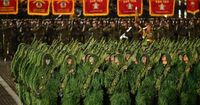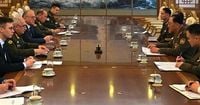Senior North Korean and Russian military officials have held high-level talks in Pyongyang this week, signaling an intensifying partnership as both countries deepen their alignment over Russia’s ongoing war in Ukraine. According to reports from North Korean state media and coverage by Yonhap and the Associated Press, the meetings come amid mounting evidence that North Korea is providing substantial military and labor support to Russia, raising concerns among regional and global observers alike.
The main event took place on November 5, 2025, when Pak Yong Il, vice director of the General Political Bureau of the Korean People’s Army, hosted Russian Deputy Defense Minister Viktor Goremykin and his delegation in Pyongyang. Both sides, as confirmed by North Korea’s official Korean Central News Agency (KCNA), discussed ways to "strengthen cooperation and exchanges between military-political organizations" as their bilateral ties continue to deepen under North Korean leader Kim Jong Un and Russian President Vladimir Putin. Notably, this marked the first visit to North Korea by a Russian military official holding Goremykin’s title, who also serves as the chief of the Main Military-Political Directorate of Russia’s armed forces.
KCNA reported that the talks focused on expanding cooperation, though no specific agreements were made public. The language used—emphasizing “deepened bilateral relations”—suggests a growing strategic partnership, but the lack of details leaves much to speculation. On the following day, November 6, Goremykin’s delegation met separately with North Korean Defense Minister No Kwang Chol, further underlining the importance both sides place on these engagements.
While the official statements remained vague, regional intelligence agencies are watching closely. South Korea’s National Intelligence Service (NIS) briefed lawmakers earlier in the week, revealing it had detected signs of recruitment and training activities in North Korea, likely in preparation for additional troop deployments to Russia. Chang Yoon-jeong, a spokesperson for South Korea’s Unification Ministry, commented that Seoul is “closely monitoring the situation but wouldn’t make assumptions” regarding the specifics of the discussions or any imminent new deployments.
South Korean assessments, reported by Yonhap and corroborated by the AP, indicate that since October 2024, North Korea has sent approximately 15,000 troops to Russia. These personnel have not only served military roles but have also included military construction workers and deminers. Kim Jong Un reportedly agreed to send thousands of such workers to Russia’s Kursk region, where they are believed to be engaged in infrastructure restoration projects and demining operations. The NIS noted that around 5,000 North Korean military construction troops have been moving to Russia in phases since September 2025.
The human cost of this cooperation is already apparent. The NIS estimated that in September 2025, about 2,000 North Korean troops had been killed during combat operations in Russia’s Kursk region. This stark figure illustrates the risks North Korean personnel are facing on Russian soil, a fact that has not gone unnoticed by regional powers.
North Korea’s support for Russia extends beyond manpower. According to South Korean intelligence and media reports, Pyongyang has supplied Russia with large quantities of artillery and ballistic missiles. These munitions are intended to bolster Moscow’s war efforts in Ukraine, where Russian forces have faced significant challenges and international sanctions have strained their military supply chains. The provision of such weaponry by North Korea is a clear sign of the two countries’ growing military interdependence, and it has sparked condemnation from Western governments concerned about the conflict’s escalation.
Amid these developments, the United States has sought to reinforce its own regional alliances. On November 5, U.S. Defense Secretary Pete Hegseth traveled to South Korea for annual security talks with his South Korean counterpart. During these discussions, Hegseth praised South Korea’s plans to raise its military spending, lauding the move as a necessary response to the “threats by nuclear-armed North Korea and other regional uncertainties.” The timing of these security talks was not lost on analysts, who noted that they coincided with the North Korean-Russian meetings in Pyongyang.
The recent flurry of diplomatic and military activity highlights the complex web of alliances and rivalries shaping Northeast Asia. For North Korea, the partnership with Russia offers both practical and symbolic benefits. Pyongyang gains a powerful international ally, access to resources, and the opportunity to assert itself on the world stage. For Russia, North Korean support provides much-needed manpower and materiel as it continues its war in Ukraine under the weight of international isolation.
The strategic calculus is not without risk. The deaths of North Korean troops in Russia and the visible movement of thousands of North Korean workers abroad could spark domestic discontent or international backlash. Yet, both Kim Jong Un and Vladimir Putin appear willing to press ahead, calculating that the benefits—military, economic, and diplomatic—outweigh the potential costs.
Observers in Seoul, Washington, and beyond are left to parse the implications of this tightening alliance. The South Korean government, while cautious in its public statements, is clearly concerned about the potential for further North Korean involvement in the Ukraine conflict. The United States, meanwhile, is using the moment to bolster its own partnerships and encourage greater regional defense spending.
Despite the high stakes, much remains shrouded in secrecy. The North Korean and Russian officials have so far refrained from disclosing any concrete agreements or operational details from their meetings. This opacity—perhaps intentional—makes it difficult for outside observers to gauge the full extent of their collaboration or to anticipate what may come next.
Still, the facts on the ground are hard to ignore. With thousands of North Korean troops already in Russia, ongoing recruitment and training, and a steady supply of arms and labor, the partnership between Pyongyang and Moscow is now a defining feature of the region’s security landscape. As the war in Ukraine drags on and both countries face continued international pressure, their alignment seems likely to grow only deeper in the months ahead.
In this rapidly evolving environment, regional actors and the broader international community will be watching closely—hoping to discern not only the next moves by North Korea and Russia, but also the broader implications for peace and stability in Northeast Asia and beyond.


